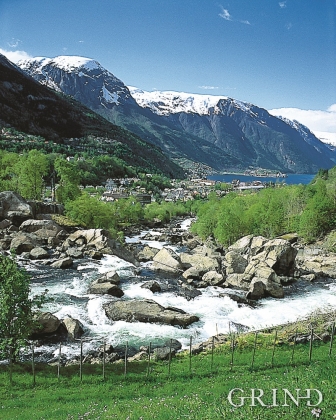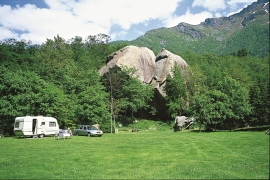Published: 06.09.2015 | Author: Inge Aarseth
OPO – THE RIVER THAT DOESN'T CARVE DEEPER
River Opo in Odda has a fall of 88 metres over the two kilometres from Lake Sandvinvatnet to Sørfjorden. This is steeper than most other rivers in western Norway that flow through sediment deposits on their way to the fjord. The Eio in Eidfjord, in comparison, has only a 19-metre fall over just as long a distance. The reason is that the Opo where the Eidesfossen waterfall runs over the side, runs over enormous stone blocks (picture lower right), which lie securely on the river bottom, even during the biggest spring floods. But why are they there?
About 11 000 years ago, a delta was deposited in front of the glacier. The sea stood 92 metres higher than today, such that the delta went out into Sørfjorden at Eide, where the stadium is today, and extended all the way to the churchyard. The glacier then advanced and deposited a moraine with huge stones onto the delta. A little later the glacier scooped together the characteristic moraine ridge that now comprises Hovden - with the tower on top, and which dams up Lake Sandvinvatnet. The path over the north end of the lake goes in front of a 12-metre high moraine block. This roughly 2500 tonne stone broke in two long after it was deposited by the glacier.
After the ice melted, the land rose, and the Opo tried to dig down through the moraine and delta terrace. Although it tried, the river failed to transport the enormous boulders. If the glacier hadn't deposited the moraine with blocks of stone onto the delta terrace, the Odda area would look quite different. Then, the river would have been able to carve down and would have sunk the level of Lake Sandivinvatnet. Down in Odda the Opo valley would also have been much deeper.





